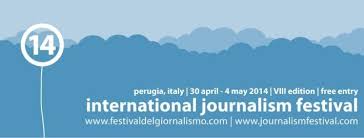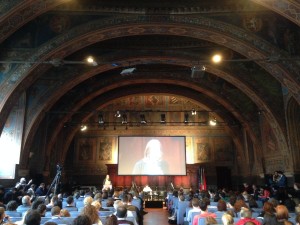
Sunrise in Perugia, Italy
By:
Gregory P. Bufithis, Esq.
Founder/CEO
The Project Counsel Group
18 June 2014 – I tell you one thing: the International Journalism Festival in Perugia forces you to be selective. At any given time, you miss more sessions than you can attend. That said, I did manage to cover a wide breadth of the festivities. Consider this a very subjective list of takeaways I took back home from Perugia, and I’ll link to a couple of other reviews at the bottom of this post, as well.
To give you a flavor of what I was able to cover/attend over the 7+ days, please see the following. The list is pretty expansive, as despite the lousy weather and continual downpour over the duration of the event, I did my best to keep moving.

Another rainy day in Perugia
The people of Umbria have a saying: Quando piove non si muove or “when its raining, its best to stay put,” sage advice I had no choice but to ignore. After all, this great event happens but once a year. My coverage:
1) Data Journalism for Small Newsrooms
2) Tracking a Person Online: Effects, Countermeasures and the Responsibility of the Media
3) Twitter Data – Beyond the Obvious
4) Metrics Beyond Pageviews: The Importance of Analytics in Delivering the Right Content, in the Right Context, to the Right People
5) Data, fact-finding and breaking news
6) Google news : The Masterclass
7) Keynote – Margaret Sullivan, public editor, the New York Times
8) Twitter: Content Discovery, Curation, Verification
9) Story-Telling: The Lingua-franca of digital communication
10) Web-scraping for non-programmers
11) Liquid newsroom, backstage
12) Data Journalism in Italy and the Mediterranean Area: From Niche to Mainstream
13) The Untold Story of Food Politics
14) How did Disqus grow so fast to one billion unique monthly visitors?
What I have written below is in no particular order … and I did not include everything I learned/saw at the 14 sessions noted above … but rather skipped through my notes, Tweets and conversations I had at the event. And many of my numbered points below overlap so just consider it my stream of consciousness.
First, some key quotes and conversations (heard and Tweeted):
«Explainer journalism is not just journalism, but journalism as it should be rather than how it had to be due to constraints.»
«We’re losing the bundle, we’re going back to something web-native.»
«No one ever in the history of the world has paid for news.»
«”Breaking news” is the most masturbatory thing journalists do. And only journalists are interested in it.»
«Develop a distinctive voice and the people will want to give you money. There is a significance of relationships in journalism. You can spread the net pretty wide globally to find people that share your passion and enthusiasm for certain subject matters, and Twitter and social media make it incredibly easy to find these people. The importance of this cannot really be understated.»
«If you’re not paying for the product, then YOU are the product.»
«Twitter does its best work in the first five minutes after a disaster, and its worst 12 hours later.»
Oh, and a continuing theme heard during the whole event, in somewhat this form: attention is the only scarcity on the web. Nobody can add a 25th hour to the day. That’s what we need to measure. Or as Tony Haile, CEO of Chartbeat, eloquently put it during the panel on Metrics Beyond Pageviews, any piece of content out there is “competing against the entire wealth of human knowledge (which we now have, more or less, accessible to us at any given moment). If I can hold your attention for three consecutive minutes… that is immensely valuable.”
Perhaps the most important note to self, though, following the Festival: Thou shalt not attend this event too early when the sessions have not started … but the pasticcerias are in full swing. Mamma mia. And watch out for the dangerously good cheese and prosciutto piadine and pizza torte during those 1 hour lunch breaks. I gained 4 kilos.
Ok, my stream of points:
1. In terms of how to get people’s attention with the cacophony of information out there, a journalist must really understand how/why/what content we consume. Many of the panels focused on that point and they all seemed to say the same thing: content needs to be either a really comprehensive take … or a ” quick snap”. For the latter, the common social media venues work best. For the former, you have the gold standards: Medium and n+1. These longer pieces … yes, you know them: the tl;dr pieces … require an average of 8 months to put together.
2. But whatever you do, IT HAS TO WORK ON THE SMALL SCREEN. There is currently somewhat of a disconnect between office desktop usage and mobile usage. Desktop usage is really only during working hours… if even then. Mobile is the king. Everybody everybody everybody at this event was using/working off/consuming via smartphones and tablets. And if they had a laptop it was a MacBook Air or similar. Side note to our e-discovery readers: our friends at Logikcull figured this out a long time ago.
3. Your knowledge must include the nitty-gritty, technical details. Know the tools you use to work. Be curious as to how “code” works to the extent that it’s useful for your business/ activities. Develop relationships with coders and programmers, and share curiosity. And quite frankly even though this advice was given with journalists in mind, the same could be, and has been, said for attorneys and T.A.R. programmers, coders, linguistics, document forensic specialists, etc.
4. Twitter is just a massive treasure trove of data. There were multiple Twitter-related sessions, with much discussion on the reach of a tweet and the “impression” (i.e. when a Tweet shows up on your feed) as a useful metric, in contrast to the sharing of the content. In sorting Twitter data, or just using Twitter in general, how do you find what you’re most interested in and/ or find out what is most relevant to you? I spoke with Torsten Muller who was a panelist and is co-founder of a start-up called Tame. He detailed how you can tailor your Twitter feed, or any data set, really, to reflect what is relevant to what you’re looking for by aggregating the data set (through an API), breaking it down through an algorithm based on a quantitative classification, displaying a relevance ranking, etc. (to our paying subscribers: you received our detailed memo). I was struck by how much of the conversation was strikingly similar to that in the e-discovery/ technology assisted review space.
5. Moreover, metrics can be viewed as a “currency”, in a way, i.e. what is a particular piece of content worth? And how does one measure worth? As I noted in the quote above, time is the really the best, the only, unit of scarcity we have to work with. Moreover, it’s not just traffic in any given moment, but “the long game” as indeed, the intent of content may not be to take up my time, but allow me to save or re-direct the time I have. In other words, am I coming back for this content, again and again? And how can we create a metric around that?
6. Mark Little, founder/CEO of Storyful.com, put a lot of the festival content in perspective. He said that every news event creates its own community. He explained what Storyful is doing and highlighted the potential most news organizations make poor use of: telling a story. From a technical perspective, it’s interesting to remember that Storyful measures what is called “velocity of conversations” in social media to identify topics and places where something unusual is happening. But it also notes the lack so many times of a story, a flood of data with no perspective.
7. Which brings me to a major point … and our e-discovery readers will identify with this … much discussed this year at the event, and also at last year’s event, the emergence (the explosion of) “data journalism”. No doubt: journalism has been thoroughly disrupted over the past decade. News organizations, especially newspapers, have come under heavy financial pressure, news bureaus have been closed or consolidated and journalists have had to rethink their profession. Yet amidst the rubble a new form of the craft has emerged: data journalism. Rather than pounding a physical beat and cultivating human sources, this new breed immerses itself in statistical data and policy papers.

Margaret Sullivan, Public Editor, The New York Times
Keynote address
Margaret Sullivan of The New York Times stressed during her Keynote address that right now is an exciting moment to be getting into journalism because of the wealth of data. Indeed, all of you have most likely read something by the two paragons of this new form, Nate Silver and Ezra Klein. Both recently left traditional outlets to create their own news organizations, FiveThirtyEight and Vox, respectively. Yet, now it looks like the model might not be as scalable as it first appeared and these new ventures already seem to be struggling. Data journalism, for all its promise, has a problem. So my next point:
8. Neither Silver nor Klein came from a traditional journalism background. Silver began his career as an economic consultant, then took an interest in sabermetrics before he started handicapping elections. Klein got his start, ironically, by getting rejected by his college newspaper. Left to his own devices, he read up on policy papers. Both created enormously successful personal blogs and were noticed by national media. Silver got a standing column at The New York Times and went on to account for as much as 20% of the traffic for the entire site. Klein created the Wonkblog at The Washington Post and reportedly generated 4 million page views per month. But as we discussed at the event, it is most often data divorced from context. Data only tells part of the story. Understanding data requires real world expertise. It requires a narrative.
And again a nod to our e-discovery readers: this was detailed brilliantly in the legal context last June in Rome at the DESI V workshop on predictive coding, machine learning, and review in e-discovery. Simon Attfield and Lawrence Chapin presented their paper on the need for narrative in the e-Discovery process, the paper entitled Predictive Coding, Story Telling and God (there is a link to that paper in the DESI link above). As they emphasized: data separated from context is a dangerous thing. Much like one of Ralph Losey’s mantras on predictive coding/computer assisted review: the quality of subject matter experts is a key factor in the success of predictive coding. The good experts know exactly what documents they need at trial to win a case. They know what they are looking for. They are the navigators. They tell the drivers where to go. They know context.
9. And this is a major point: having relevant data and making common-sense conclusions is fine. If you get it right. Having a lack of expertise can cause you to misinterpret. Data journalism is, in many ways, a disruptive innovation. Journalism can be an expensive proposition. You have to pay reporters to travel to where the story takes place, observe events in person, cultivate and interview countless sources. In comparison, performing statistical analysis of data sets or poring over policy documents is a relatively cheap and labor-saving way to operate. At the same time, sometimes there are only so many facts on the ground and over-reporting can be tiresome — as when CNN engages in what Jon Stewart has described as “disaster porn.” So in that sense, data journalism offers a useful alternative perspective. But as we learned in Perugia, there is nothing mutually exclusive about traditional reporting and data journalism. In fact, they are clearly complementary. Traditional journalists could benefit from more data literacy and objective analysis, while data journalism would be much improved by real world context.
10. The Guardian’s Aron Pilhofer noted the best pieces are those where the data part is fully immersed in the story. Data journalism should be part of the story, not the story itself. And there are scores of tools out there like Carto DB that will allow anyone to play data journalist/ story-teller. Story-telling in digital communication …. the power of data-visualization and story-telling with data … should not be underestimated. People especially relate to maps, as they allow for easy visualization, and allow content users to quickly see where they stand in relation to the data/ how it relates to them .
11. Design. The new management tool. Actually, it’s the “put-design-into-everything” tool. Largely due to Apple’s unprecedented success, design has recently become extremely fashionable in the broader business imagination. Journalists have become multimedia design experts. Because an effective multimedia story allows the audience to focus less on the fact that there are multiple story forms and more on the story as a whole. Thus, packaging multimedia content is a complex process for a number of reasons. It is easy to assume that because the Web is the only place we can combine all story forms, multimedia design is merely an exercise in Web design. However, as an increasing number of people use other devices for the consumption of information, we must recognize other platforms when we create and package multimedia content. Mobile phones, tablet devices, and touch screen interactivity must all factor into our design and presentation processes. All are they key to journalists needing to hit their markets.
12. But … too often, both practitioners and audiences define “multimedia” storytelling as only a digital media endeavor. However, a true multimedia approach to storytelling is not limited to Web-based formats, but also includes other platforms, such as print and broadcast. Newspapers and magazines have contained multiple story forms for decades in their packaging of text, photos, and information graphics. Television news has too, with video, audio, photos, and graphic animations. Additionally, most print and broadcast organizations also publish Web sites; and some are even publishing mobile media sites and tablet-based applications.
13. Perhaps the most helpful sessions: the ones on information architecture. Information architecture relates to the interpretation and expression of information for complex delivery systems. For journalists, systemic, structural, and orderly decisions are paramount to a good story and ease of use. You need to bring it all together. Consider how the individual parts of a story are consumed and whether they make sense independent of the package. Due to the fact that most multimedia presentations are nonlinear, each user may take a different path through the stories we construct.
14. Oh, and I finally got a grounding in content management systems. A content management system (CMS) is based on a collection of procedures that help manage collaborative workflow. A good CMS for journalists allows a group of people within the organization to contribute and share content, from video files and written pieces, to photos and graphics. It’s application/use in the legal industry is obvious (hence the platoons of lawyers at this event).
So, so much more to tell but I agreed to keep this post brief. For some other links/review of the Festival:
